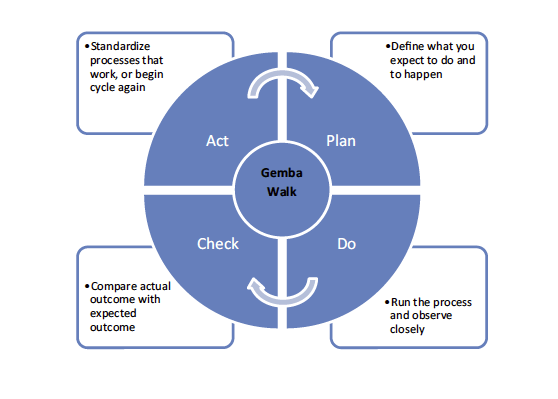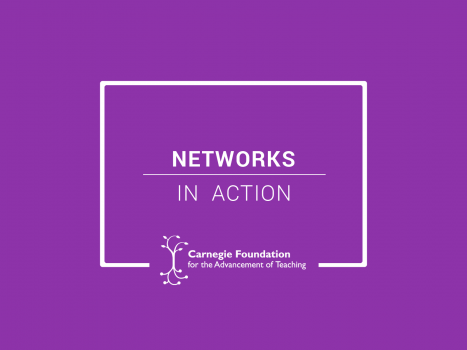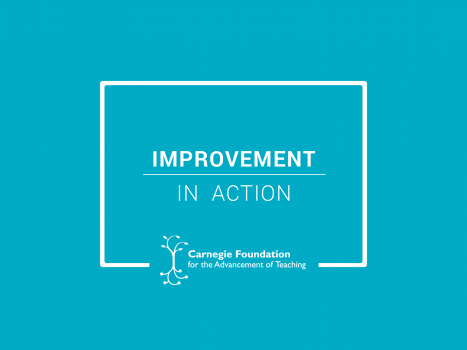Editor’s note: The current issue of Quality Assurance in Education is a special one, devoted entirely to exploring seven different improvement-based approaches to change being used in schools. Over several weeks, beginning February 23, the Carnegie Foundation will publish a blog post summarizing each of the models, including the process, examples, and pros and cons. “Lean for Education” is written by Paul G. LeMahieu of the Carnegie Foundation; Lee E. Nordstrum with RTI International; and Patricia Greco, superintendent of Menomonee Falls School District, Wisconsin. We hope that these summary blog posts will whet your appetite to delve more deeply into the journal issue itself.
Lean for education is an improvement approach that encourages all school and district employees to identify and solve problems that prevent students and others who benefit from education from achieving the highest quality outcomes possible. The Lean model has its roots in manufacturing, specifically the performance and quality standards movement developed by Toyota Motor Corporation following World War II. Toyota sought to improve on an earlier production system created by Ford Motor Company, which was more concerned with standardization and efficiency than with inspiring workers to feel committed to ongoing quality improvement.
Whereas Ford’s workers had highly specialized roles and supervisory foremen, Toyota’s system had teams with team leaders who not only supervised, but also performed production tasks and filled in for absent workers. Teams were assigned sets of assembly steps, tasked with figuring out the best way to accomplish them, and given dedicated time for improving their processes through team-based problem-solving techniques. In education, where it can be difficult to define concepts like “products,” “customers,” or even “quality,” the Lean method has not yet seen extensive use; its applications have been mostly in higher education and non-instructional areas such as administration and facilities.
Fundamentals of the Model
Lean offers a set of tools and techniques (discussed below) as well as overarching principles for thinking about organizational improvement. While the method is fundamentally about achieving efficiency and quality, it also emphasizes the importance of relationships. Service providers (teachers and administrators) must know what their customers (students and parents) need and value in order to deliver the best product. Likewise, managers and frontline workers must have close working relationships with each other to effectively solve problems together.
Lean organizations know that there is always something that can be improved, and they conduct iterative, rapid cycles of learning. At the heart of the model is the Plan-Do-Check-Act (PDCA) cycle (see Figure 1), which is very similar to (and descended from the same predecessors as) the Plan-Do-Study-Act (PDSA) cycle of the Carnegie Foundation’s Networked Improvement Model, described in an earlier chapter of the special issue of Quality Assurance in Education. PDCA cycles are built around the idea of gemba, a Japanese term signifying the importance of going to the actual workplace to directly observe conditions and ask questions.

Figure 1
Lean in Action: What’s the Problem?
The School District of Menomonee Falls (SDMF), a small district serving over 4,200 children in the Milwaukee area, is one example of the Lean approach in action. The district’s improvement practices include a combination of Lean and Six Sigma (another improvement method discussed in the special journal issue).
Unlike other approaches that assign improvement work to select groups of individuals inside and/or outside an organization, workers and teams within a Lean organization are themselves not only empowered, but expected, to identify issues and work to solve them. Within SDMF, for example, problems are identified and addressed by everyone from district-level administrators to classroom staff; even students use Lean’s improvement tools. The goal is to produce “expert problem solvers,” explained Superintendent Patricia Greco (and co-author of the Lean section of the journal) in an earlier blog post.
Education practitioners must meet these three conditions to successfully identify problems to be solved:
- They must fully understand how students (and other customers, such as parents and community) perceive value, and know what value looks like to them.
- They must internalize how this idea of value can be translated into a set of standards and processes, known as a target condition, that schools and districts engage in.
- They must be empowered to halt production at any time to address problems in quality. (Toyota empowered every employee to push a button that stops the assembly line when they notice a defect.)
Lean organizations typically focus their improvement efforts on underlying causes of more visible issues. Problems are called “waste” (which, by definition, do not add value for the customer) and fall into eight categories: motion waste, delay, inefficient conveyance, correction or reworking mistakes, over processing, excess inventory, overproduction, and wasted talent or knowledge.
In school districts that employ the Lean approach, superintendents acknowledge that, while often overlooked, efficiency is an essential improvement goal, yet school administrators aren’t taught how to achieve it. “The bulk of my graduate education was focused on instruction, not on managing an organization,” said Greco, adding that good management is fundamental to building quality organizations.
Lean in Action: Finding, Testing, and Spreading Solutions
Solutions, referred to as “countermeasures” in Lean terminology, often come from individuals or teams engaged in the on-the-ground work of the organization (though they can also come from team leaders/managers) and are tested in PDCA cycles. The plan phase involves determining the solution and predicting what the outcomes will be in terms of both process and success for the users. The do step is actually implementing the countermeasure and collecting data on the process and its outcomes. In the next phase, the actual outcome is checked against the original hypothesis and prediction. Then, the act phase analyzes what has been learned, standardizes what works, and, possibly, starts a new cycle of learning.
PDCA cycles are key to Lean’s objective of establishing flow, the rapid spread of knowledge and information. The authors describe this process as “getting the right information to the right people at the right time” in order to quickly build into one PDCA cycle changes resulting from what was learned in the previous PDCA cycle. It’s also the reason that PDCA cycles are conducted at different scales and rates.
The School District of Menomonee Falls conducted PDCA cycles to prototype and test changes designed to improve early literacy skills, reading comprehension, vocabulary development, and math skills among kindergarten students. Because Lean thinking, as the name implies, centers on rapid and efficient processes, the classroom PDCA cycles ran for 10-15 days and were followed by professional development sessions where teachers shared what worked and what didn’t work. Other teachers then learned to implement the new practices and began a new cycle.
Another way that Lean promotes sharing knowledge is through value stream mapping, which facilitates learning about the entire lifecycle of a product or service by identifying every aspect of process. Menomonee Falls utilizes a knowledge-sharing approach called the A3 management process, which serves as its internal reporting document and quarterly report to the school board, and is essentially a storyboard that serves as a visual representation of the problem-solving method and the communications strategy between key stakeholders in the organization. The storyboard includes the name of the problem, the person responsible for overseeing the improvement process, background on the issue, desired outcomes, analyses of what caused the situation, proposed solutions, an action plan to achieve the outcomes, and a follow-up or review process. The entire storyboard fits on a single page, which is why it’s known as A3. That’s the European paper size used for the report, which is about the equivalent of 11-inch by 17-inch paper used in the United States.
Translating concepts such as “customer,” “product,” and even “value” from the world of manufacturing to service industries can be complicated, however, and is perhaps one reason why the Lean model has not yet seen much use in education. However, Lean’s underlying principles and emphasis on iterative learning, continuous improvement, and worker empowerment would be an applicable and welcome approach to addressing many of the types of problems faced in education.
April 11, 2017
Five-year studies show that Carnegie’s network approach to improving developmental math increased both student success in college-level math and transfer rates from 2-year to 4-year colleges compared to students in traditional remedial math, even as enrollment quadrupled.
April 25, 2017
Variability is everywhere in education. Everything from a school’s location to the textbooks it uses impact student learning. The Six Sigma approach to improvement emphasizes data analysis to reduce variance and inefficiency in school processes to help all students succeed.






